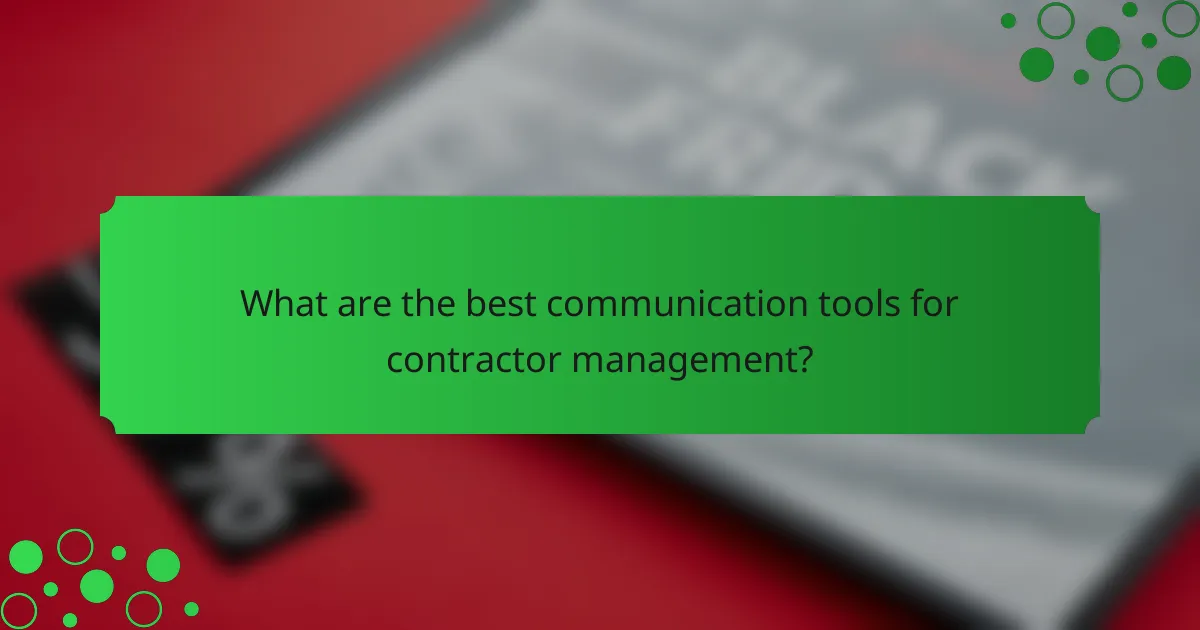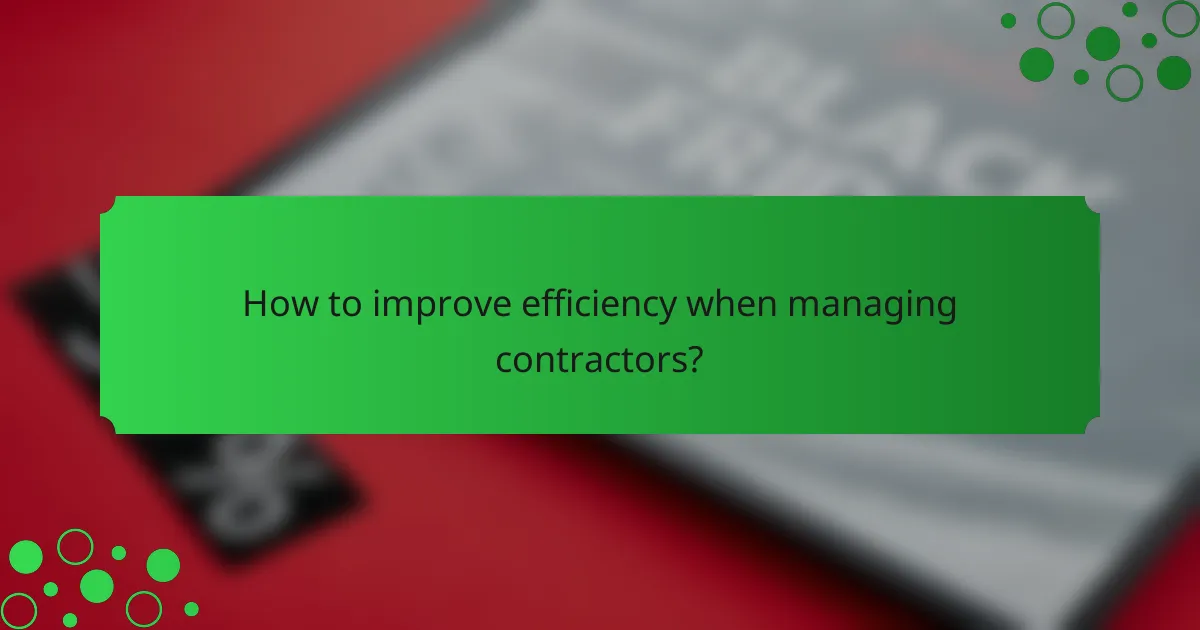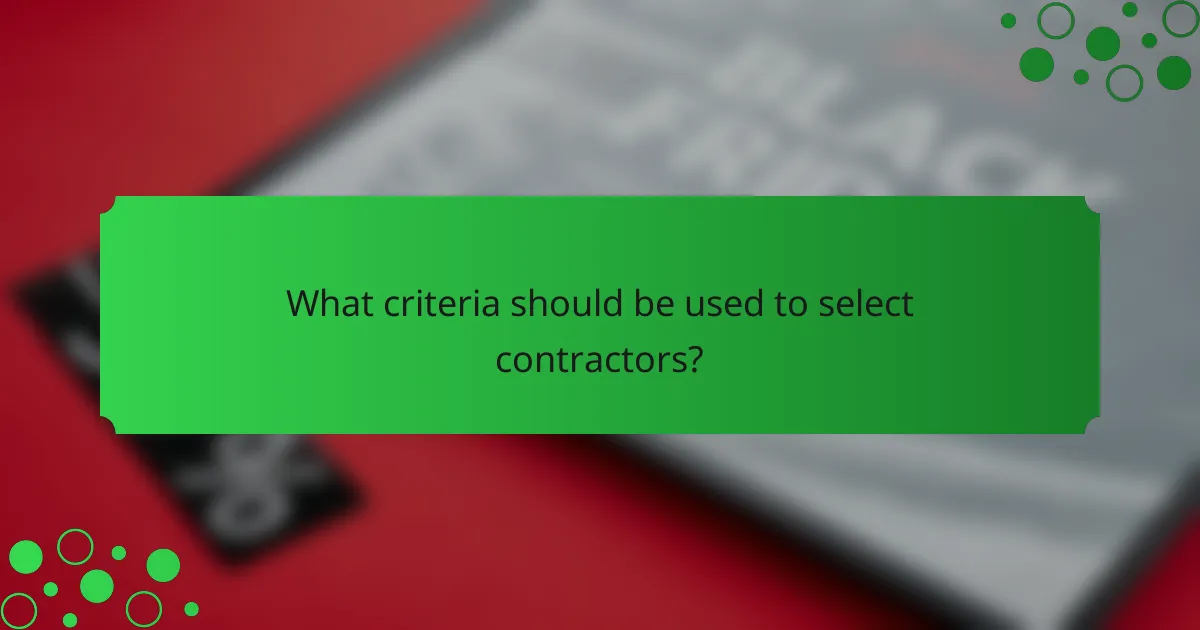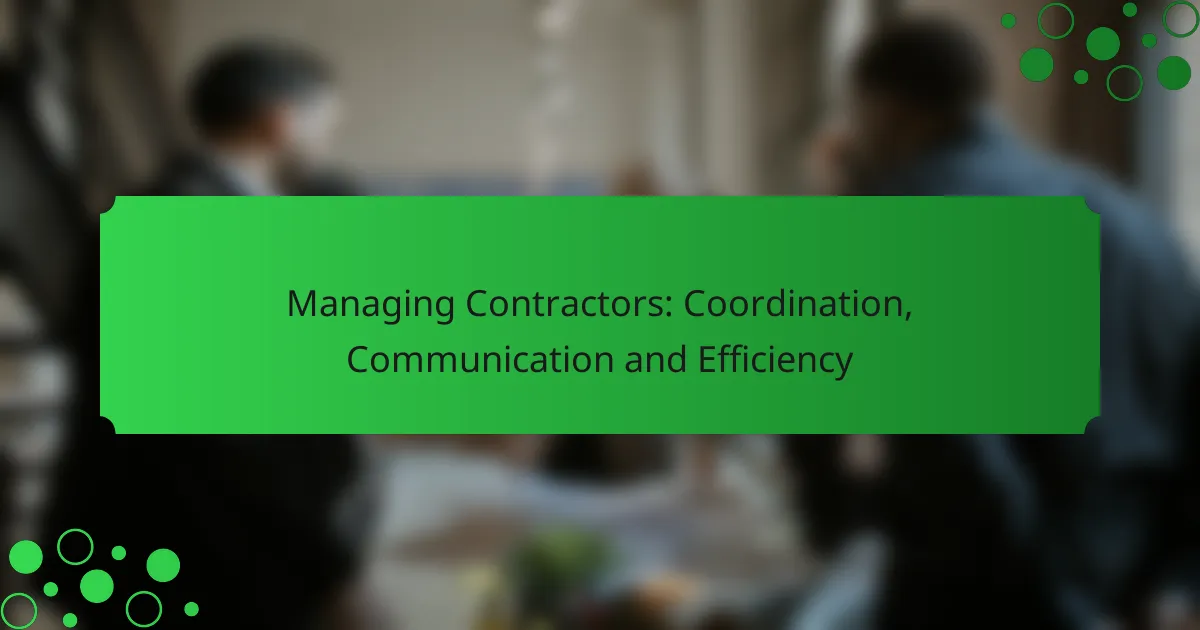Managing contractors effectively requires a focus on coordination, communication, and efficiency. By establishing structured processes and utilizing the right communication tools, you can enhance collaboration, minimize delays, and ensure that project objectives are met. Implementing these strategies not only streamlines operations but also boosts overall productivity in urban projects.

How to effectively coordinate contractors in urban projects?
Effective coordination of contractors in urban projects involves streamlined communication and organized workflows. By implementing structured processes, you can enhance collaboration, minimize delays, and ensure project objectives are met efficiently.
Utilize project management software like Asana
Using project management software such as Asana can significantly improve contractor coordination. These tools allow you to assign tasks, set deadlines, and track progress in real-time, ensuring everyone is on the same page.
Consider creating a centralized project board where all contractors can view their responsibilities and updates. This transparency helps prevent miscommunication and keeps the project moving forward smoothly.
Implement regular check-in meetings
Regular check-in meetings are crucial for maintaining alignment among contractors. Schedule these meetings weekly or bi-weekly to discuss progress, address challenges, and adjust timelines as necessary.
During these meetings, encourage open dialogue to foster collaboration and problem-solving. This practice not only keeps everyone informed but also builds a sense of teamwork among contractors.
Establish clear roles and responsibilities
Clearly defining roles and responsibilities is essential for effective contractor coordination. Each contractor should understand their specific tasks and how they contribute to the overall project.
Consider creating a roles matrix that outlines each contractor’s duties and points of contact. This clarity helps prevent overlaps and ensures accountability, reducing the risk of confusion during project execution.
Use shared calendars for scheduling
Shared calendars can streamline scheduling and improve coordination among contractors. By using a common calendar tool, all team members can see important dates, deadlines, and meetings in one place.
Encourage contractors to update their availability and any scheduling conflicts promptly. This practice helps avoid last-minute changes and keeps the project timeline intact.
Define communication protocols
Establishing clear communication protocols is vital for effective contractor coordination. Determine the preferred channels for different types of communication, such as email for formal updates and messaging apps for quick questions.
Additionally, set expectations for response times to ensure timely communication. This structure helps maintain momentum and prevents misunderstandings that could derail project progress.

What are the best communication tools for contractor management?
Effective communication tools are essential for managing contractors efficiently. The right tools facilitate real-time collaboration, task tracking, video conferencing, and formal communications, ensuring everyone stays aligned and productive.
Slack for real-time messaging
Slack is a popular platform for real-time messaging among teams and contractors. It allows users to create channels for specific projects or topics, making it easy to keep conversations organized and accessible.
When using Slack, consider setting clear guidelines for communication to avoid information overload. Encourage team members to use threads for specific discussions, which helps maintain clarity and context.
Trello for task tracking
Trello is an effective tool for visual task management, allowing teams to organize projects using boards, lists, and cards. Each card can represent a task, which can be assigned to contractors with due dates and checklists.
To maximize Trello’s effectiveness, regularly update the status of tasks and hold brief check-ins to ensure everyone is on track. This keeps the workflow transparent and helps identify bottlenecks early.
Zoom for video conferencing
Zoom is widely used for video conferencing, making it ideal for face-to-face meetings with contractors, especially when remote work is involved. It supports features like screen sharing and breakout rooms, enhancing collaboration.
For successful Zoom meetings, establish a clear agenda and share it in advance. This helps keep discussions focused and ensures that all participants come prepared, maximizing the value of the meeting time.
Email for formal communications
Email remains a crucial tool for formal communications, such as contracts, project updates, and official announcements. It provides a written record that can be referenced later, which is important for accountability.
When using email for contractor management, be concise and clear in your messages. Use bullet points for key information and ensure that all relevant documents are attached to avoid back-and-forth exchanges.

How to improve efficiency when managing contractors?
Improving efficiency in managing contractors involves clear communication, structured processes, and effective monitoring. By implementing specific strategies, you can streamline operations and enhance productivity.
Set clear project timelines
Establishing clear project timelines is crucial for managing contractors effectively. Define start and end dates for each phase of the project, and communicate these deadlines to all parties involved. This helps in aligning expectations and ensuring everyone is on the same page.
Consider using project management tools that allow you to visualize timelines, such as Gantt charts. These tools can help track progress and highlight any delays, enabling timely adjustments to keep the project on track.
Use templates for repetitive tasks
Utilizing templates for repetitive tasks can significantly enhance efficiency when working with contractors. Create standardized documents for contracts, reports, and communication to save time and reduce errors. This ensures consistency and clarity in all interactions.
For example, if you frequently need to send out project briefs, develop a template that includes all necessary information. This not only speeds up the process but also helps maintain a professional standard across all communications.
Monitor progress with KPIs
Monitoring progress through Key Performance Indicators (KPIs) is essential for assessing contractor efficiency. Identify relevant KPIs such as project milestones, budget adherence, and quality of work. Regularly review these metrics to gauge performance and make informed decisions.
Set up a simple reporting system where contractors can update their progress against these KPIs. This transparency allows for quick identification of issues and fosters accountability, ensuring that projects remain on schedule and within budget.

What criteria should be used to select contractors?
Selecting contractors involves evaluating several key criteria to ensure they meet project requirements effectively. Focus on their experience, reliability, and financial health to make informed decisions.
Evaluate past project experience
Assessing a contractor’s past project experience is crucial for understanding their capabilities. Look for relevant projects similar in scope and complexity to yours, as this indicates their ability to deliver results.
Consider the duration and scale of previous projects. Contractors who have successfully completed projects within your industry are often better equipped to handle specific challenges.
Check references and reviews
Gathering references and reviews from previous clients provides insight into a contractor’s reliability and quality of work. Reach out to past clients to ask about their experiences, focusing on communication, timeliness, and problem-solving skills.
Online reviews can also be helpful. Look for patterns in feedback, paying attention to both positive and negative comments to gauge overall satisfaction.
Assess financial stability
Evaluating a contractor’s financial stability is essential to ensure they can complete your project without interruptions. Request financial statements or proof of insurance to assess their economic health.
Consider their payment history and any outstanding debts. Contractors with strong financial backgrounds are less likely to face cash flow issues that could impact project delivery.

How to handle conflicts with contractors?
Handling conflicts with contractors requires a structured approach to ensure resolution while maintaining professional relationships. Addressing issues promptly and effectively can prevent escalation and foster a collaborative environment.
Establish a conflict resolution process
A clear conflict resolution process is essential for managing disputes with contractors. This process should outline the steps to take when a disagreement arises, including who to contact, how to document the issue, and the timeline for resolution.
Consider implementing a tiered approach, starting with informal discussions before escalating to formal mediation if necessary. This can help resolve minor issues quickly and maintain a positive working relationship.
Encourage open communication
Open communication is vital for preventing and resolving conflicts with contractors. Encourage regular check-ins and feedback sessions to discuss progress, expectations, and any concerns that may arise.
Utilize tools like project management software or communication platforms to facilitate transparency and keep all parties informed. This proactive approach can help identify potential issues early and foster a culture of collaboration.
